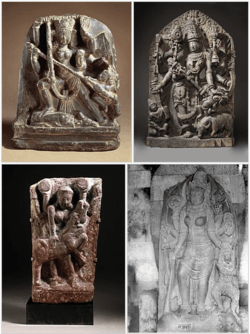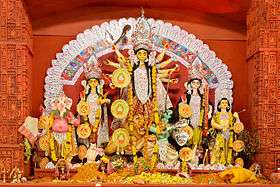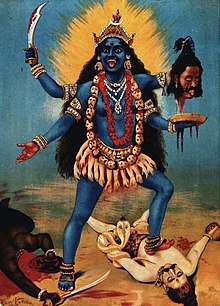Mahishasura
Mahishasura was a buffalo Asura in Hinduism. He is known among most sections of Hindus for his deception and as someone who pursued his evil ways by shape shifting into different forms.[1][2][3] He was ultimately killed by Goddess Durga getting named Mahishasuramardini. It is an important symbolic legend in Hinduism, particularly Shaktism. The legendary battle of Mahishasura as evil and Durga as good is narrated in many parts of South Asian and Southeast Asian Hindu temples, monuments and texts such as the Devi Mahatmya.[4][5][6] The story is also told in the Sikh text Chandi di Var, also called Var Durga Di, which many in Sikh tradition believe was included in the Dasam Granth by Guru Gobind Singh.[7]

The Legend of Mahishasura
Mahishasura is a Sanskrit word composed of Mahisha meaning buffalo and Asura meaning demon, or Buffalo Demon. As an Asura, Mahishasura waged war against the Devas, as the Devas and Asuras' were perpetually in conflict. Mahishasura had gained the boon that no man could kill him. In the battles between the gods and the demons, the Devas led by Indra were defeated by Mahishasura. Dejected by their defeat, the Devas assemble in the mountains where their combined divine energies coalesce into goddess Durga. The newborn Durga led a battle against Mahishasura, riding a lion and killed him. Thereafter she is named Mahishasuramardini, meaning The Killer of Mahishasura.[3][8]
Mahishasura's legend is told in a major text of the Shaktism tradition known as the Devi Mahatmya, which is part of Markandeya Purana. The story of Mahishasura is being told in the chapter where Markandeya is narrating the story of birth of Savarnika Manu (Ref Vishnu Purana). As per the Markandeya Purana, the story of Mahishasura was narrated in 2nd Manvantar (approximately 1.3 Billion years ago as per Vishnu Purana) by Maharishi Medha to a king named Surath, as an incident which occurred in times ancient for even 2nd Manvantar. Therefore, the period in which Mahishasura story is placed is supposed to be several billion years ago, as per the narrative of the Markandeya Purana and explanation of Manvantars given in Vishnu Purana. The geography, society, living beings on earth were all different compared to the social set up in other Hindu mythology, contrary to assumption of modern interpretations of the caste or varna of Mahishasura. He is described as an evil being who can change his outer form, but never his demonic goals.[8] According to Christopher Fuller, Mahishasura symbolically represents forces of ignorance and chaos hidden by outer appearances.[9][2] The symbolism is carried in Hindu arts found in South Asia and southeast Asia (Javanese artwork, for example), where Durga is shown as serene, calm, collected and graceful symbol of good as she pierces the heart and kills the scared, overwhelmed and outwitted Mahishasura.[10][2]
Mahishasura in Art
Durga slaying Mahishasura is a prominent theme which was sculpted in various caves and temples across India. Some of the prominent representations are seen at the Mahishasuramardini caves in Mahabalipuram, the Ellora Caves, in the entrance of Rani ki vav[11] Hoysaleswara Temple in Halebidu and many more temples across India. The worship of Durga during Durga Puja in Bihar, West Bengal, Jharkhand, Odisha and other eastern states is represented in Pandal which depict Durga killing Mahishasura.[12] The legend of Mahishasura has also been inspiration to films, plays and dance dramas.[13]
Mahishasura & Mysore
The popular legend is that Maisuru gets its name from Mahishasuramardini, a manifestation of Goddess Durga. The Buffalo demon Mahishasura, states the regional tradition, had terrified the local population. Goddess Durga (Chamundeshwari) killed Mahishasura, an event that is annually celebrated at Navratri and Mysore Dasara.[14]
The temple of the city's guardian deity, Chamundeshwari, has a giant statue of Mahishasura on the hill facing the city. The earliest mention of Mysore in recorded history may be traced to 245 B.C., i.e., to the period of Ashoka when on the conclusion of the third Buddhist convocation, a team was dispatched to Mahisha Mandala.[15]
Gallery
 Durga killing Mahishasura, 9th century Sirpur temple, Chhattisgarh.
Durga killing Mahishasura, 9th century Sirpur temple, Chhattisgarh. Durga is depicted in the Hindu pantheon as a Goddess riding a lion and with many arms, each carrying a weapon to defeat Mahishasura or the buffalo demon
Durga is depicted in the Hindu pantheon as a Goddess riding a lion and with many arms, each carrying a weapon to defeat Mahishasura or the buffalo demon Buffalo-headed Mahishasura in Cave Temple, Mahabalipuram
Buffalo-headed Mahishasura in Cave Temple, Mahabalipuram Mahishasura at Durga's foot in Aihole temple
Mahishasura at Durga's foot in Aihole temple Durga is worshiped in her Mahishasuramardini form, during Durga Puja
Durga is worshiped in her Mahishasuramardini form, during Durga Puja
See also
References
- Bane, Theresa (2012). Encyclopedia of Demons in World Religions and Cultures. McFarland. p. 214. ISBN 978-0-7864-8894-0.
- Amazzone, Laura (2012). Goddess Durga and Sacred Female Power. University Press of America. pp. 96–97. ISBN 978-0-7618-5314-5.
- Kinsley, David (1988). Hindu Goddesses: Visions of the Divine Feminine in the Hindu Religious Tradition. University of California Press. pp. 96–103. ISBN 978-0-520-90883-3.
- Jones, Constance; Ryan, James (2014). Encyclopedia of Hinduism. Infobase Publishing. p. 399. ISBN 978-0816054589.
- Rocher 1986, pp. 191-192.
- June McDaniel 2004, pp. 215-216, 219-220.
- Singh, Pashaura; Fenech, Louis E. (2014). The Oxford Handbook of Sikh Studies. Oxford University Press. pp. 241–243. ISBN 978-0-19-100412-4.
- Lochtefeld, James G. (2002). The Illustrated Encyclopedia of Hinduism: A-M. The Rosen Publishing Group. p. 410. ISBN 978-0-8239-3179-8.
- Fuller, Christopher John (2004). The Camphor Flame: Popular Hinduism and Society in India. Princeton University Press. pp. 108–109. ISBN 0-691-12048-X.
- Zimmer, Heinrich (1990). Myths and Symbols in Indian Art and Civilization. Motilal Banarsidass. pp. 195–198. ISBN 978-81-208-0751-8.
- mahishasuramardini. "Rani ki vav". Frontline. Retrieved 26 January 2016.
- Durga Puja, Encyclopaedia Britannica
- Ahalya, Performing Arts. "Mahishasura Mardhanam - Dance drama". Ahalya Performing Arts. Retrieved 26 June 2020.
- "Mysuru name". mysore.org.uk. Retrieved 27 January 2016.
- "DISTRICT CENSUS HANDBOOK MYSORE" (PDF). Census of India 2011 KARNATAKA. SERIES-30 PART XII-B: 8. 2011. Retrieved 31 January 2016.
- Hindu Goddesses: Vision of the Divine Feminine in the Hindu Religious Traditions, David Kinsley. (ISBN 81-208-0379-5)
- Mahishasura Mardini Stotram (Prayer to the Goddess who killed Mahishasura), Sri Sri Sri Shankara Bhagavatpadacharya
- McDaniel, June (2004). Offering Flowers, Feeding Skulls. Oxford University Press. ISBN 978-0-19-534713-5.CS1 maint: ref=harv (link)
- Pintchman, Tracy (2014). Seeking Mahadevi: Constructing the Identities of the Hindu Great Goddess. State University of New York Press. ISBN 978-0-7914-9049-5.CS1 maint: ref=harv (link)
- Pintchman, Tracy (2015). The Rise of the Goddess in the Hindu Tradition. State University of New York Press. ISBN 978-1-4384-1618-2.CS1 maint: ref=harv (link)
- Rocher, Ludo (1986). The Puranas. Otto Harrassowitz Verlag. ISBN 978-3447025225.CS1 maint: ref=harv (link)
External links
| Wikimedia Commons has media related to Mahishasura. |
- Devī Māhātmya by Swami Sivananda at Divine Life Society
_(14454518575).jpg)

